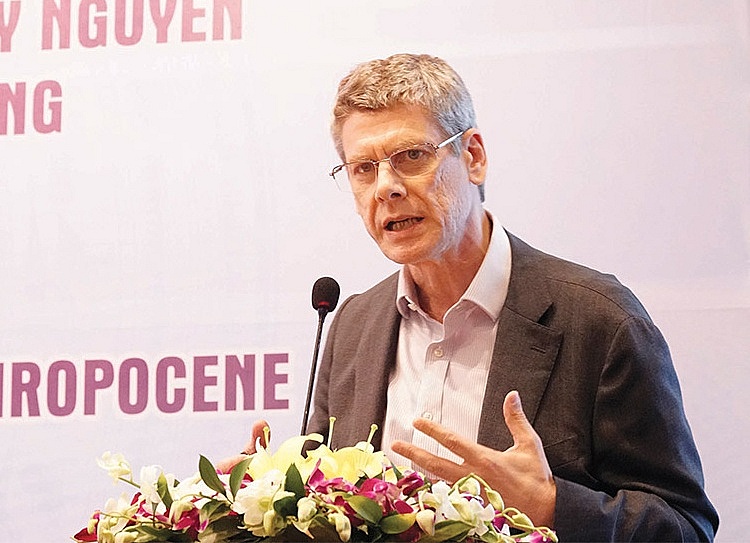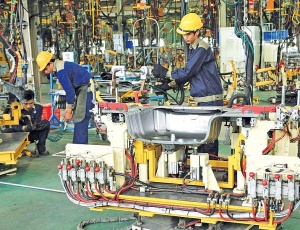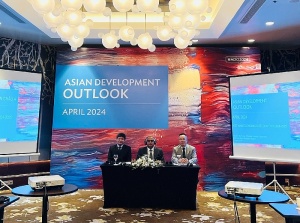Core principles of growth still apply
Vietnam is a nation transformed. In the nearly five decades since national reunification, the Vietnamese people have emerged from the devastation of war and isolation to build one of Asia’s most dynamic and outward-looking economies.
 |
| Jonathan Pincus, senior international economist at the United Nations Development Programme in Vietnam |
Economic growth has averaged 6.5 per cent per annum since 1986, second only to China and significantly faster than other ASEAN countries. Sustaining high rates of growth over such a long period is an historic achievement, which few countries have managed to equal.
Economic transformation has affected every aspect of life. When the economic reforms in the 1980s were introduced, Vietnam was an agrarian society, in which most people were self-employed on small farms. The first systematic household survey in the early 1990s found that nearly four out of five households lived in conditions of extreme poverty. Only one-third of children of secondary school age were enrolled in school in 1992 compared to 95 per cent today.
Income per person has increased five-fold since 1990 and extreme poverty has been reduced to the low single digits. Vietnam’s commitment to human development is evident in the country’s pioneering use of multidimensional poverty indicators in poverty monitoring and social assistance policy. According to the Multidimensional Poverty Index, introduced in 2016, multi-dimensional poverty has been reduced by more than half.
The daily lives of Vietnamese people have been transformed by economic growth and investment in infrastructure and public services. Now nearly half of the labour force comprises wage and salaried workers, up from one-fifth just 20 years ago.
While only 7 per cent of workers 55 years and older have some form of university qualification, the corresponding figure for younger workers (from 25 to 54 years of age) is 17 per cent. Vietnam is increasingly an urban society, with more than half of the population expected to be living in cities by 2030.
Ambitious goals
Vietnam’s development experience carries many important lessons for other developing countries. First and foremost, Vietnam has demonstrated an unwavering commitment to human development, including access to health and education for people living in rural areas. This commitment has been supported by large-scale investment in essential public infrastructure, including irrigation and drainage, transportation, universal electrification and access to clean water and sanitation.
Export-led growth has formed the core economic strategy for more than three decades, encompassing both manufactured goods and agricultural commodities. Deep regional and global trade integration, combined with a cautious approach to volatile global capital flows, has positioned Vietnam to benefit from globalisation while avoiding some of the largest costs. Finally, Vietnam has progressively tackled obstacles to entrepreneurship and the growth of small businesses.
Vietnam has set an ambitious target of achieving high-income status by the time of the nation’s centennial in 2045. This implies annual average growth of more than seven per cent, which will not be an easy task given global economic headwinds and potential disruption from the negative effects of climate change and other environmental risks.
As a densely populated, coastal country, Vietnam is vulnerable to sea level rise, flooding, salinisation of agricultural zones, and damage to infrastructure and housing from extreme weather conditions. It is expected that millions of people will be forced to relocate due to the effects of climate change, increasing pressure on urban services, housing and infrastructure.
Systematic regional planning and additional public investment are needed to build resilience and disaster proof people’s lives and livelihoods. At the same time, the government needs to create conditions for a rapid transition from fossil fuel dependence, both to reduce dependence on import energy and to ensure that exports are not hampered by tariffs and other trade barriers.
Geopolitical tensions are also on the rise, leading some observers to question the viability of Vietnam’s export-led growth model. However, it is important to keep these challenges in perspective. Vietnam can point to several key advantages that it enjoys over other countries that will help sustain exports over the long term.
Vietnam is deeply embedded in Northeast Asian production systems and will continue to benefit from the diversification of regional supply chains. The workforce is literate and numerate, and skill levels are improving. Vietnam’s high female labour force participation rate is also an advantage.
As a leading exporter of agricultural commodities, including food, Vietnam has enjoyed great success stabilising domestic food prices, and ensuring food security, even during periods of market instability.
The widening gap
Yet Vietnam cannot be complacent despite these advantages. Increasingly, exports of manufactured goods will be determined by technological capabilities and the capacity to innovate. Vietnam is rapidly approaching the so-called Lewis Turning Point, or the transition from a labour-surplus to full-employment economy.
Before the turning point, the movement of underemployed people in the rural sector to more productive jobs in factories or modern services was a major source of growth. Once the turning point has been reached, productivity growth will largely come from within sectors – from producing higher value-added manufactured goods, agricultural products and services. Growth after the turning point implies a shift from labour to capital-intensive production, higher skill levels, and rapid technological change.
In the age of AI, robotics and bioprinting and advanced materials, the gap between the developing world and countries at the technological frontier has widened. Global research and development (R&D) spending has doubled in constant US dollars since 2008 and is now approaching $3 trillion per year. However, R&D spending is highly concentrated, with the United States, China, Japan, South Korea, and Germany together accounting for 74 per cent of the total in 2021, according to UNESCO.
Although the share of the top five countries has not changed much over the past two decades, the relative contribution of each country has: Most notably, China’s expenditures increased from 4 per cent of the total in 2000 to 26 per cent in 2021, just four percentage points behind the United States. The concentration of R&D effort is reflected in the distribution of patents, with the same five countries generating 81 per cent of global patent applications according to the World Intellectual Property Organization.
Vietnam’s national innovation system is still at a relatively early stage of development, with the country accounting for 0.2 per cent of global R&D spending and 0.3 per cent of patent applications. Increasing the country’s technological readiness will require additional funding for research and for science and engineering programmes in national universities and research institutes.
Another problem has been weak coordination among government agencies, which has reduced the effectiveness of the many programmes introduced to build capacity and stimulate technological innovation.
Demographic change is another challenge to the country’s growth strategy. Vietnam is currently enjoying a demographic dividend, with a relatively low dependency ratio of about one dependent – child or retiree – to every working adult. However, due to low birth rates and longer life expectancy, Vietnam will meet the formal definition of an ageing society by the middle of the next decade.
However, only about one-third of working people have access to a formal sector pension, and many of these participants have already cashed out their savings to cover immediate expenses. Reform of the social protection system is urgently needed to avoid a situation in which millions of families suffer a sudden fall in income and consumption as employees reach retirement age. Households need greater incentives to save for the future, savings that can help finance the country’s massive investment requirements.
Vietnam’s performance over the past five decades suggests that the country will find ways to manage the challenges of climate change, bridging the technology gap and preparing for an ageing society, while sustaining growth and development.
The core principles that have propelled growth still apply: Vietnam’s will maintain a strong focus on human development, especially among poor and vulnerable citizens; the government will sustain investment in essential public infrastructure, including renewable energy; and export-led growth as the centrepiece of the industrial strategy.
With these policies in place, Vietnam will meet is goal of achieving the Sustainable Development Goals by 2030, and high-income status by the time of the nation’s centennial celebrations in 2045.
| Christanto Suryadarma, sales vice president, Southeast Asia, Zebra Technologies
To compete in today’s market, manufacturers need improved quality, faster cycle times, and increased visibility and flexibility, all while meeting regulatory compliance. In 2023, Vietnam ranked 46/132 in the Global Innovation Index and second among 37 lower middle-income group economies. While Vietnam has come a long way, there is still some gap to close before they can truly become a global manufacturing hub. To achieve that, tech and innovation will play a key role in improving Vietnamese manufacturers’ productivity, product quality, and competitiveness to get them up to the desired level. This is where our solutions come in, by enabling manufacturers with greater visibility to make decisions swiftly, which translates to cost savings and better business results. Nguyen Quoc Tuan, general manager Pebsteel Vietnam
The pre-engineered building sector in Vietnam is currently facing a landscape of challenges and opportunities. Disrupted supply chains and reduced projects have led to intense competition within the construction industry. The fluctuating costs of raw materials also affect the pricing and profitability of pre-engineered projects. On the opportunity front, Vietnam is witnessing a rising demand for pre-engineered buildings with a huge investment wave from many developed countries. Furthermore, the country’s socioeconomic growth indicates a resilient industrial and construction sector. The segment in Vietnam stands at the cusp of significant growth opportunities driven by market demand and the advantages that such buildings offer over traditional construction methods. Kalidas Ghose, chairman UNOBank
In the emerging economies of South and Southeast Asia, traditional stores have around 70-90 per cent market share, and it is steadily growing through both modern trade and e-commerce. This also creates an informal job industry covering about 10-12 per cent of the adult population. This part of the economy cannot stay out of formal finance. Additionally, when included, they can complete the supply demand with bank customers forming the demand to complete a marketplace and use embedded finance for lubricating the transaction machine and increase volume covered in the formal financial system. In turn, the data created in the marketplace can be leveraged to provide access to credit to small businesses and further accelerate the process. Federico Vasoli, managing partner dMTV Global
The prominence of FDI in Vietnam has been pivotal, as it not only fuels innovation and technology but also enhances management capabilities while broadening export horizons. Yet, Vietnam must fortify its allure for FDI with streamlined procedures and reduced bureaucratic hurdles. Simplifying processes and slashing unnecessary red tape are imperative to attract and retain investment. Upholding the rule of law and reinforcing international legal frameworks for enforcing foreign judgments will instil confidence among investors. Vietnam must invest in nurturing a highly skilled workforce to meet the demands of a rapidly evolving economy. Embracing technology and prioritising legal frameworks will also fortify Vietnam’s appeal in the global investment landscape. Keith Strier, vice president Worldwide AI, Nvidia
Nivida has not been an overnight success. It took over 30 years to create the ecosystem with our partners, and that’s how we bring value to the world. We see an opportunity to partner with FPT in different domains to lift the economy here. Nvidia wants to be FPT’s partner not only in business but also in transforming Vietnam. By accelerating innovation in healthcare, agriculture, climate, manufacturing, and more, AI has the potential to improve lives and strengthen the economies of every nation. FPT is working with us to empower organisations throughout Vietnam to drive transformation, helping the country become an AI nation. In the next 12 years, we aim to have one million workers. We plan to invest in super AI computing platforms, research and development, and services to create huge value and make a happier future. |
 | Stock market shows potential for growth Amidst a landscape of economic uncertainties, banking, retail, and real estate sectors are identified as beacons of growth, bolstered by strategic government interventions. |
 | Vietnam's economic growth expected to pick up in 2024 Vietnam’s economy is expected to post 6 per cent growth in 2024, up from 5.1 per cent growth in 2023, on the back of improving external demand, a pickup in domestic demand, and robust foreign direct investment (FDI) inflows, according to a report by the ASEAN+3 Macroeconomic Research Office (AMRO) released on April 9. |
 | ADB forecasts 6 per cent growth for Vietnam According to the Asian Development Outlook released by the Asian Development Bank (ADB) on April 11, slowing global demand and high international interest rates hampered Vietnam’s growth last year, yet Vietnam's economy is expected to grow 6 per cent in 2024 and 6.2 per cent in 2025. |
What the stars mean:
★ Poor ★ ★ Promising ★★★ Good ★★★★ Very good ★★★★★ Exceptional
Related Contents
Latest News
More News
- Pivotal stage of growth paves way for rise in M&As (December 03, 2025 | 10:00)
- Positive projections for M&A interest from Thailand (December 03, 2025 | 09:40)
- Manifesting the first line of defence in cybersecurity (December 03, 2025 | 09:00)
- The transformational role AI can play in accounting arena (December 03, 2025 | 08:00)
- Unlocking 5G-AI potential in Singapore (December 03, 2025 | 08:00)
- Data-driven strategies vital for a fast-evolving nation (December 02, 2025 | 09:41)
- Policy to practice: how Vietnam can lead the region (November 26, 2025 | 16:03)
- Mobilising private capital at scale vital for climate battle (November 26, 2025 | 15:36)
- VILAF and Yoon & Yang launch Vietnam - Korea Practice Unit (November 26, 2025 | 15:16)
- Trademark disputes challenge foreign firms in Vietnam (November 24, 2025 | 15:30)






 Tag:
Tag:




















 Mobile Version
Mobile Version